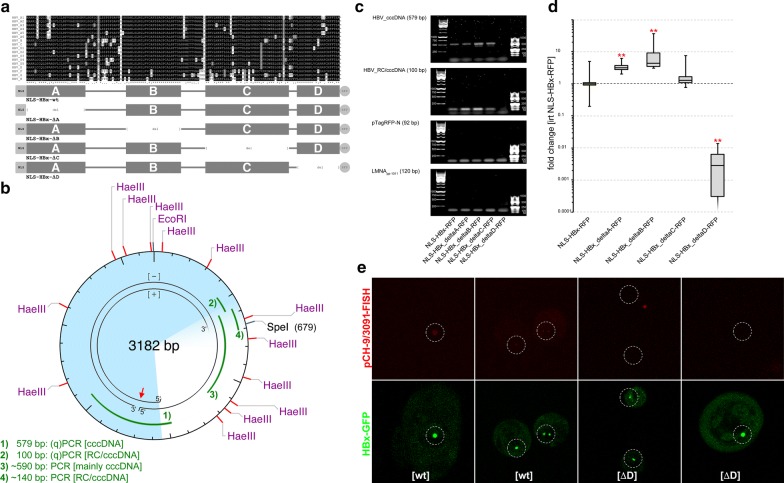Fig. 2.
Co-immunoprecipitation of several transfected HBx-constructs and cccDNA as well as co-localization analyses using the F2H cell system. a HBV occurs as several different genotypes and sub-genotypes. a Shows the alignment of HBx protein sequences for HBV genotypes A–H including sub-genotypes. Sequential agreement is shaded in black, common variations are gray, single differences are highlighted white. This figure demonstrates four regions with a large degree of agreement (indicated as blocks A–D below the protein sequences) and variation mostly between those regions. Outlined below is a scheme of several HBx-constructs that were used in subsequent experiments. Specifically, the constructs feature a nuclear localization signal as well as an RFP signal and either the full-length HBx (first row) or HBx depleted by blocks A, B, C or D (rows 2–5). As a control, full-length HBx-RFP with a nuclear export signal was used (not shown in this figure). b This genomic HBV map illustrates the features of RC DNA, the position of restriction sites of interest as well as the amplified regions (1–4; green lines) targeted by specific primer pairs used in this study. The red arrow points to the nick region of the minus-RC DNA strand. c Analyses of cccDNA association with nuclear HBx-RFP complexes enriched by immunoprecipitation. Results are shown from semiquantitative PCR HBV cccDNA which was amplified with two different primer pairs resulting in 579 bp (genotype D3) or 100 bp amplicons, respectively. RFP (92 bp) amplicons were used to assess the plasmid load; Lamin A/C (LMNA, 120 bp) amplicons were used to assess the amount of host genomic DNA per sample. Notably, the signal for cccDNA when HBx-ΔD-GFP was immunoprecipitated is significantly weaker when compared to the other, clearly visible bands. d qPCR derived analysis of cccDNA enrichment utilizing IP directed against HBx-RFP. This figure outlines the fold change in gene expression of cccDNA, normalized to the cccDNA signal when full-length HBx-RFP was pulled down. Importantly, the signal for HBx-ΔD-GFP derived cccDNA is significantly attenuated. **Indicates p < 0.05. e Results of sequential image acquisition in F2H assays, where HBx(wt)-GFP spots co-localized with faint HBV genome FISH signals (left image quartet). In contrast, no HBV genome FISH signals could be identified, when HBx-ΔD-GFP was used for co-transfection (right image quartet), although the GFP spots were not distinguishable in both experiments. The phase contrast-like field of view was used to identify overlapping slide areas before and after FISH (not shown). Dashed circles mark areas with nuclei where the GFP-binding platform was localized

